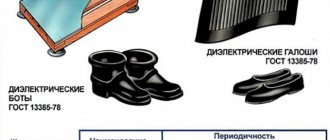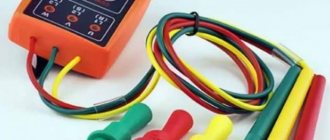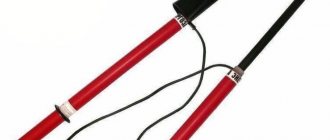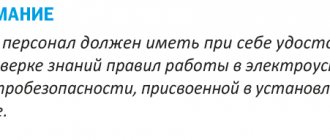Purpose of dielectric gloves
Protective equipment is part of an electrician’s overalls and is required when working with any electrical devices and electrical cables. The purpose of the products is to provide protection to the human body in case of contact with live current conductors.
Used for electrical work:
- connecting and disconnecting current collectors with voltages above 800 V;
- replacing high voltage fuses;
- working with fishing rods on electrical equipment;
- replacement of lighting fixtures;
- manipulations with the reversible element of the switchgear;
- disconnecting the transformer terminals.
In an emergency, use a fire extinguisher while protecting your hands with electrically insulating gloves.
Products are produced with the following markings:
- En - as the main means of protection at voltages below 1000 V;
- EV - used as an additional protective agent at installations above 1 kV.
Basic PPE
When working with high voltages, dielectric guards are used as an auxiliary protective equipment with electrical insulating clamps, rods, and high voltage indicators.
Testing dielectric boots and galoshes
Testing dielectric boots and galoshes
Dielectric boots and overshoes protect against step voltage and are classified as additional personal protective equipment, overshoes for installations up to 1000 V, and overshoes for installations up to and above 1000 V. Externally, overshoes and overshoes should look like this: rubber top, rubber corrugated sole, textile lining. Boots must be no shorter than 160 mm and have cuffs. Dielectric boots are tested by applying a voltage of 15 kV, and dielectric overshoes are tested by applying a voltage of 3.5 kV for 1 minute. If the flowing current does not exceed 2 mA for galoshes, and 7.5 mA for boots, the products are considered to have passed the test.
Classification
Dielectric gloves are made of sheet rubber or latex. The material must have low electrical conductivity and high ductility. Gaiters are produced seamless and with a seam (rubber only), two-fingered and five-fingered.
Glove length and thickness
Three types of protective products are available:
- for fine work - thickness of at least 4 mm;
- ordinary;
- for tough work - thickness of at least 9 mm.
According to GOST, the length of dielectric gloves is 35 mm. The size is selected taking into account the possibility of lifting knitted gloves inside in cold weather and pulling the bells of the product onto the sleeves of overalls. The blue rectangle is a table, the contents of which are described below.
Also read: Why does the LED light blink when the lights are off?
Types of protective equipment
Products are divided into the following types:
- An ordinary dielectric mat, the price is low, the service life is limited.
- Oil and petrol resistant used in aggressive environments. Often placed on stands.
Depending on the conditions of use, the dielectric mat has a fixed size. The price depends on the dimensions. Products are divided according to standard values:
- Length 500-1000 mm. Can be more than 1000 mm and up to 8 m. Cost - from 100 to 500 rubles.
- Width - 500-1200 mm.
- Thickness - 6±1 mm.
Specialized dielectric mats are sold at prices above 500 rubles. Stands, depending on the design, can cost several thousand rubles. Unique products made to order (according to the customer’s drawing) have negotiable payment and production time.
In humid environments, it is recommended to use an insulated stand. It is a high-rigidity dielectric surface placed on legs made of a similar material. The height of the products starts from 70 mm. The flooring is laid out from wooden blocks with a gap of more than 30 mm. For the legs, special insulators of the CH-6 type are used. Additional protection can be provided by a rubber mat placed on the surface of the stand.
Requirements for gloves
Electrical insulating products are made in a two-layer design of different colors with markings on the outside. The stamp contains the following information:
- product name;
- date of manufacture;
- batch number;
- date of the next survey;
- type, marking;
- warranty period of operation.
Protective products are made from natural rubber. When performing electrical work, it is allowed to use only specialized products manufactured in accordance with the specifications. Hermetic gloves with an expired expiration date that have not been tested within the specified time frame are subject to rejection.
Rules for testing protective equipment in electrical installations
Classification of personal protective equipment
There is a verification methodology approved by government and industry documents. Order of conduct:
- Mechanical tests should be performed before electrical tests.
- All testing work is carried out by employees who have undergone preliminary training and certification. Failure to comply with this requirement is considered a gross violation and entails administrative liability.
- Before inspection, protective equipment must be carefully inspected to identify the manufacturer's mark. The completeness must be complete. Insulating surfaces are checked for the absence of any mechanical damage.
- Electrical tests must be performed with alternating current. The temperature regime must be observed (from plus 25 to minus 15 °C).
- Currents flowing through insulation and voltage indicators up to 1000 V are standardized.
- After electrical testing and parameter measurements, protective equipment made from solid materials is checked by palpation to detect the presence or absence of local heating.
- In case of breakdown or detection of discharges on the surface, exceeding the norms of current values through the test medium, heating, the product is rejected.
Important! It is prohibited to use a product with damage or defects identified during testing.
Products used for electrical safety must be stamped. The stamp marking must include the name of the product, manufacturer, date of manufacture, period of periodic testing.
If there is no stamp or after the verification period has expired, the protective agent cannot be used. The use of such products will be considered a violation of safety regulations with a risk to health.
Check before use
Before starting electrical installation work, the condition of protective equipment is checked each time. Electrical insulating gloves must meet the requirements:
- The date on the stamp indicates the tests were carried out according to the specified deadlines;
- The integrity of the product is preserved - there are no punctures or microcracks. This is verified by twisting the glove in the direction of the fingers; filling the object with air confirms the tightness.
- Must be dry and free from contamination.
- Gloves must be suitable in size, the thickness of the rubber must correspond to the nature of the work performed.
Before use, contaminated products are washed in soda or soap solution and dried thoroughly at room temperature. In some cases, it is permissible to wear leather or canvas mittens over dielectric gloves. It is prohibited to bend the top edges of the protective equipment.
Frequency of inspections
The service life of dielectric gloves is one year (subject to tests carried out once every 6 months). The warranty period is indicated on the packaging.
The first time tests are carried out upon receipt of a new batch of electrical protective products. They take one pair and test them. If an insulation breakdown occurs, take two pairs of protective gloves and test more thoroughly. If the products fail the test again, the entire batch is rejected and returned to the manufacturer.
Upon successful completion of testing, a stamp is placed on each pair of gloves indicating the testing period (after six months). The results of the checks are recorded on a special form.
Tests
Dielectric leggings are tested in special laboratories. Protective equipment must withstand a load of 6 kV for 60 seconds with a current flow of no more than 6 mA. The voltage is supplied from a transformer, one terminal of which is connected to the tank, the other is grounded. For testing, a packet switch with two positions is used through a gas-discharge lamp or a milliammeter with shunt grounds.
Also read: What is a surge suppressor (SPD)
1 – connection to a voltage source; 2 – bath with water; 3 – water inside the glove and bath; 4 – electrodes (rod) for connecting water to two poles of the voltage source; 5 – distance from the edge of the glove to the water in the bath
Research sequence:
- The tested products are placed in a metal container filled with water at a temperature of 25-35˚C. The waterproof gloves are positioned so that the upper part, 55 mm long, is above the surface of the water and remains dry, while the inner lower part is filled with liquid to the water level in the bath.
- Switch in first position. An electrical circuit is created - a transformer-gas-discharge lamp-electrode, which is placed in the glove. A switched-on lamp is an indicator of insulation breakdown due to a violation of integrity or insufficient dielectric properties of the product material. If there is no breakdown, the test continues.
- The switch is placed in the second position. The electrical circuit is a transformer-milliammeter-electrode located in the product and grounded through a milliammeter.
If the lamp lights up, the readings on the device are more than 6 mA, or the device needle oscillates, the gloves are considered unsuitable for use. Products that have passed the test are dried at room temperature. The research results are recorded in a technical journal. During their service life, protective products are tested twice.
Testing hand-held power tools (side cutters, screwdrivers, pliers, pliers)
Hand power tool testing
Power tools, such as pliers, screwdrivers, pliers, wire cutters, are used as the main electrical protective equipment when working on electrical installations up to 1000 V. Requirements for the appearance and quality of insulation of power tools are described in the “Rules”; if they do not meet them, the products are considered unsuitable. In operation, only electrical insulation tests of hand tool handles . Tests of power tools with single-layer insulation are carried out by applying a voltage of 2 kV for 1 minute. Testing of tools with insulating handles having double or triple insulation is carried out with the integrity of all coatings.
Storage
When transporting products with changes in ambient temperature, the batch is left unpacked in the warehouse. The analysis of received kits can begin within 24 hours.
Rubber is destroyed under the influence of ultraviolet radiation, heat, mineral oils, gasoline, and alkaline solutions. The storage room must be protected from direct sunlight, have a temperature from -30 to +40˚С, and a humidity of 40-60%. Increased dust content in the warehouse is eliminated. Gloves should be kept away from heating devices and central heating radiators.
Dielectric gloves perform protective functions against electric shock if the operating rules are followed and high-quality, undamaged products are used that have been tested within the specified time frame.
Key points and terms
Electrical protective equipment - (items) that serve to protect people from electric shock, exposure to an electric arc or electromagnetic field when working in electrical installations.
They are divided into basic and additional.
Basic electrical protective equipment - their insulation can withstand the operating voltage of electrical installations for a long time, which allows you to touch live parts that are energized.
Additional electrical protective equipment - by itself cannot provide protection against electric shock and is used in conjunction with basic electrical protective equipment.
All electrical protection means in electrical installations must meet the requirements of state standards.
I recommend that when purchasing them, be sure to check the availability of certificates of conformity. Especially if you are buying them for your staff. Because if you are a manager and a malfunction is discovered, they will ask you.
Personnel carrying out repair work on electrical installations must be fully provided with all the necessary protection, trained in the rules of their use, and must use them to ensure the safety of the work.
Protective equipment must be present as an inventory in electrical installation rooms. Can also be issued for individual use.
You should only use electrical protective equipment that is marked, indicating the manufacturer, name or type of product and year of manufacture.
Be sure to pay attention to the test stamp! He must be present. If the test period has expired, you have the right not to start work
Remember this and always pay close attention to this. Your safety is at stake and more.
Insulating electrical protective equipment should be used only for their intended purpose and in electrical installations with a voltage no higher than that for which they are designed. This data is written in the operating manual, instructions, passport for a particular electrical protection device
Also pay attention to the weather conditions in which you are going to work.
We will not go into details about storage conditions, just a few words - protective equipment must be stored in conditions that ensure serviceability and suitability for use; they must be protected from mechanical damage, contamination and moisture.
To get an electrical safety permit, you need to know all this!
Now more about the exam, as promised.
Testing protective equipment in electrical installations, ignorance of standards and deadlines, this is not the main criterion for my failure. Everything went well, I explained what kind of protection there is in electrical installations, how to provide assistance to a victim in case of electric shock (release, artificial respiration, external cardiac massage, etc.). Internal labor protection rules. And when they asked me what work I had already done and how I checked the absence of voltage, I showed my homemade voltage indicator.
That's all I failed! Who knows, he understood. Well, for those who don’t know, it is prohibited to use homemade devices and test lamps (a socket with an incandescent lamp and two wires) to check the voltage. I assembled this index myself, under the strict guidance of a colleague who is 74 years old, an electronics engineer and knows what’s what. I still use it to this day, it works well.
=> Next exam.
Joke:
— What is step voltage? - This is the tension that arises between the legs when approaching the bare end...










